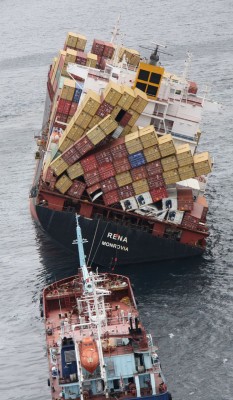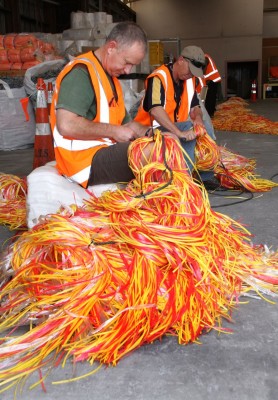Divers To Construct Dam For Rena’s Next Step
In total, 808 tonnes of oil have been removed from the Rena, leaving 575 – 600 tonnes on board.
Salvors have now pumped as much oil as possible from the port number five fuel tank on the stranded vessel Rena, allowing attention to shift to the more difficult to access tanks on the ship.

Rena undertaking fuel transfer to tanker Awanuia | MNZ
Maritime New Zealand Salvage Unit Manager Kenny Crawford said the port number five tank was now almost empty, with only residual amounts of oil left. This would be dealt with later in the salvage process, he said.
“There’s only the dregs left in the port number five tank now and that’s really good news. Getting this oil off is an important milestone and we can now focus on clearing the starboard and settling tanks. Mr Crawford said the salvage team would be working around the clock in an effort to get oil pumping from the starboard tank.
“However, this will be an extremely difficult and complex operation, as the starboard tank is underwater and divers will need to construct a dam so water can be removed before an attempt can be made to pump oil from the tank.”

Oil spill responder Matt Cunningham reparing snare boom | MNZ
Captain Jon Walker, a specialist salvage consultant for MNZ, also reiterated the challenging conditions in which the salvors were working. “These operations are very complex and very dangerous. Salvors are working underwater and in pitch black on a ship that is listing heavily.”
. Attempts are also being made to connect pumps to the settling tanks on the port side of the ship, so oil from them can be removed to the Go Canopus tug. But progress has been slow due to extensive damage to the ship’s hull.
National On Scene Commander Nick Quinn said oil spill clean-up efforts were focusing on rocky areas around MountMaunganui and Leisure Island, and noted that old oil was still resurfacing along the foreshore at Papamoa Beach.
The 5-10 tonne oil slick that leaked from the Rena on Saturday is still being monitored and Mr Quinn said a forward operations base had been established in Whangamata to assist with this.
“We haven’t received any reports of oil reaching the Coromandel yet but we are making sure we are prepared,” said Mr Quinn. “We have people monitoring the situation and others ready to go at short notice.”
Volunteer Coordinator Pim de Monchy praised the hard work of the 6,700 registered volunteers and said more were needed to assist, starting with two scheduled clean-ups 10am tomorrow at Tay Street, Mt Maunganui and at the Taylors Road end of Taylor’s Reserve, Papamoa East. More clean ups were also planned throughout next week.
“We’ve had over 3,000 volunteers help out so far and they’ve done the same amount of work as one person working full time for four years. That’s a great effort,” says Mr de Monchy.
Mr de Monchy also thanked the many businesses and corporates who had helped provide people and resources to the volunteer effort, and called for any more that were willing to help to step forward.
“The clean up effort is going to take weeks, if not months, so we need as many volunteers as possible. I really encourage anyone who has a few spare hours to make sure they’re registered to come down and help. Even those from further afield are welcome to come for the weekend and lend a hand.”











1 Comments
An oil spill is the release of a liquid petroleum hydrocarbon into the environment, especially marine areas, due to human activity, and is a form of pollution. The term is usually applied to marine oil spills, where oil is released into the ocean or coastal waters, but spills may also occur on land.